Carat Infini, Belgium; is proud to bring forth before you a wide selection of precious, semi-precious, simulants, synthetic and man made lab- grown gemstones inlaid within various metal combinations. We believe in giving the customer the choice to choose what best suits their needs. While nothing glitters and sparkles quite as much as a real gem, our simulant and man made stones are closest to what constitutes a real stone; and are not easily distinguished with the naked eye. The goal with such gemstones is to provide low cost gemstones, with the same brilliance and fire, similar to a diamond.
A simulant has the appearance of a natural gemstone, but differs in its physical, optical and chemical properties. Moissanite and cubic zirconia are both well known diamond simulants. Moissanite has many optical properties of a real diamond, but is twice as much refractive. A simulant may also be a natural gemstone, that is cut to perfection and made to look like and sold as a more expensive gem.
A synthetic gemstone, is a lab created gemstone, and may have essentially the same physical, optical and chemical properties of a real gemstone. So a synthetic diamond, could be considered to be a real diamond; although it doesn't have all the little natural imperfections that could be a part of a real diamond that got created over thousands of years.
Although there is no universally accepted grading system of gemstones, GIA ( Gemological Institute of America) since the 1950's devised a system to grade diamonds accordingly. It uses the mnemonic device of 4 C's - namely: Colour , Cut, Clarity & Carats. These four criteria carry different weight depending whether the gemstone is a coloured gemstone or a colourless diamond, that is being graded.
Colour Comparison
In nature, diamonds come in various colours and hues. Its actually very difficult to find a purely transparent natural diamond. A diamonds' or simulants' colour is very important to make a purchase, because of its behaviour and the physics of light that takes place when it passes through the different mediums of light. Thus, colourless diamonds are a prized possession due to its reflective qualities. Neverthess, we now see a trend slowly building for diamonds in pink, red, blue, and even orange.
The GIA grades diamonds from E to Z, where E stands for the colourless variety while K -Z will fall into the tinted coloured diamonds. True fancy coloured diamonds are graded on a different colour scale. Most man made , lab created diamonds, are near perfection in terms of colour and fall within the D-F grade.
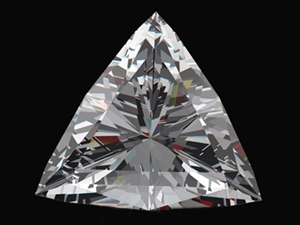
DEF
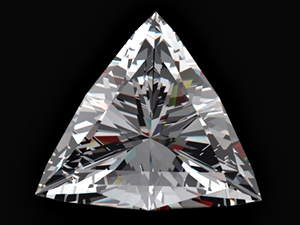
GHIJ
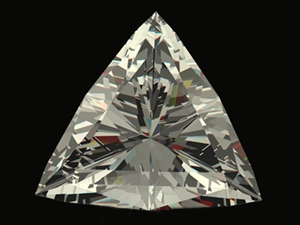
KLM
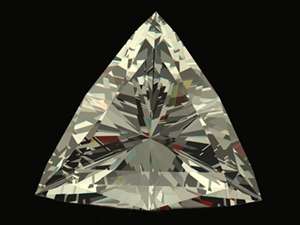
NOPQR
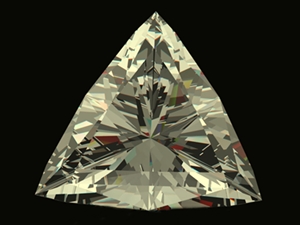
STUVW
Although there are very mild difference in the colour of a diamond graded D,E and F ; these can only be determined by a gemologist when the diamonds are placed next to each other; and can rarely be seen by an untrained eye. These stones should preferably be set in platinum or white gold to bring out their true intrinsic colour and effect.
The GHIJ diamonds carry within them a slight trace of colour. If these are placed in white gold settings, it helps negate the effect of this tint and will have a tendency to look more like the higher range diamonds. Due to the slight tint, they are available at a lower price point too, so will be a good go inbetween, for maximum value at a cheaper cost.
Diamonds graded K onwards have a visible tint that can be noticed by a naked eye. If set in yellow gold, they tend to radiate a lovely hue that can be appreciated by many. These are available at almost half the price compared to a diamond graded as a G.
It may be noted, that colour plays an important part based on the stones Carat weight. The higher the number of carats, the bigger the stone, the more visible the colour will be.
Clarity of the Stones
While grading diamonds, the flaws within it are categorised as blemishes and inclusions. Blemishes are any scratches or chips that are externally visible. Inclusions are internal flaws seen inside a diamond. The lesser these blemishes and inclusions, the higher is its clarity and its price.
Based on clarity, diamonds are graded into different categories:
FL - These diamonds are FLAWLESS, and do not have any blemishes or inclusions visible under 10x magnification.
IF - These are INTERNALLY FLAWLESS, so have no inclusions. They may contain minute external blemishes, but are barely visible even to a skilled grader under 10x magnification
VVS1 & VVS2 - These diamonds are considered to be VERY, VERY SLIGHTLY INCLUDED diamonds, which are very hard to detect under 10x magnification.
VS1 & VS2 - These VERY SLIGHTLY INCLUDED diamonds are fairly hard to be detected under 10x magnification and dont really impact the beauty of the diamond.
SI1 & SI2 - Diamonds under this category are known as SLIGHTLY INCLUDED; and have inclusions that can be easily noticed under 10x magnification, and may even be visible with the naked eye.
I1 , I2 & I3 - These are known as INCLUDED and are very obvious using 10x magnification. These are adversely impact the diamonds transparency, brilliance and durability.
It maybe noted that, higher the carat, the more the flaws would be visible. Thus, due attention needs to be rendered while making a choice based on a diamonds clarity factor. Man-made lab simulants will be always flawless in clarity, since anything less is easily discarded owing to its cheaper manufacturing costs.
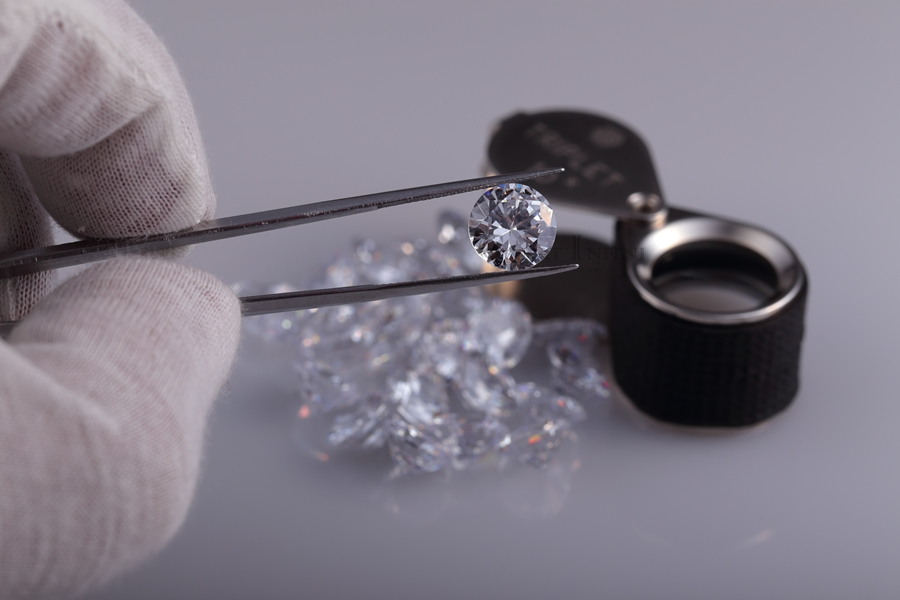
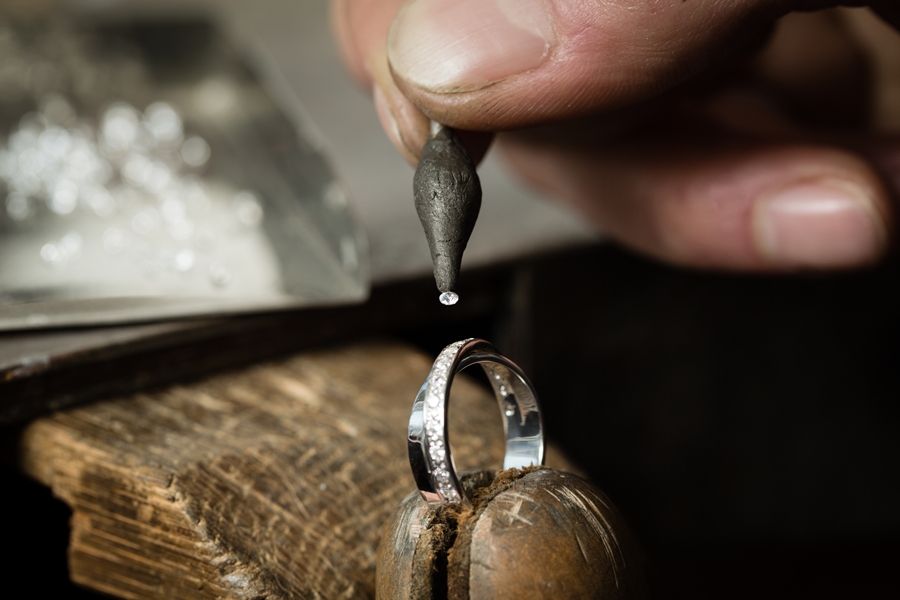
Hardness of Our Stones
Hardness is the resistance of a gemstone or other material offers to scratching or abrasion. Natural diamonds are known to be very hard stones measuring a high 10 on the Moh's scale. Most of our simulant and lab created stones, dont lag too behind and are a good 8.5 on the Moh's scale. Diamonds being hard, do not really get scratched easily and are more durable in nature. Synthetic simulants on the other hand may have a tendency to get scratched and require more care due to their softer physical properties.
It is considered good practice to use gemstones with a grade of 6.5 and above on the Moh's scale as settings in rings, as they are more durable. Stones with a grade of 5 on the Moh's scale for hardness work fine for necklaces and earrings that do not face as much rough handling as a ring does.
Nevertheless, it maybe noted, that a gemstone may be hard, but comparatively fragile. A sharp blow rendered on the side of a weakness, can break apart even a diamond. Thus, while considering hardness, one needs to remember that its only in relation to the stones capacity to get scratched , rather than its resistance to breakage.
Carat Weight
Carat weight is one of the most important criteria for choosing and pricing of a diamond. Technically, one carat is equal to 200 milligrams or 100 points. Thus a one carat diamond ring will mean that you have a 0.2g diamond on the ring. Nevertheless, it is imperative to realise that although carat weight is one of the key factors to decide which diamond to buy, It is best done in conjunction with the CUT grade of the diamond and its physical diameter; so that its brilliance and fire are optimally visible.
Best Stone Cutting Practices
Most people consider a diamond cut and a diamond shape to be one and the same thing. Its isn't so. While shape refers to the outline a diamond has, like round, princess, emerald etc.; the cut refers to the combined aspects of a diamonds proportions and finishings. Thus, the cut of a diamond, can be considered as the most important feature that brings out the brilliance and beauty from within its core.
A better cut can make a diamond look bigger, hide inclusions and even improve the visible colour of the stone. Having the diamond cut perfectly, can bring out all its intrinsic characteristics to the foreground and prevent the carat weight within the diamond to be hidden. When cut well, the light that enters into the diamond, will reflect back well, making it appear whiter and brighter. This increased intense scintillation and fire can hide its flaws under its sparkle.
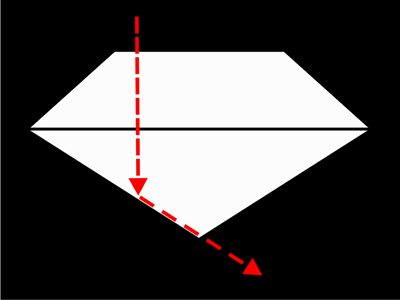
TOO SHALLOW CUT - LIGHT IS DEFLECTED DOWN
The amount of sparkle and scintillation seen within a diamond is dependent on how the rays of light are reflected and refracted back into the diamond. In a shallow cut, the light is not reflected back, but instead is seen to be deflected out from the lower end of the diamond. Thus it will not be seen to have a darker and less brilliant appearance.
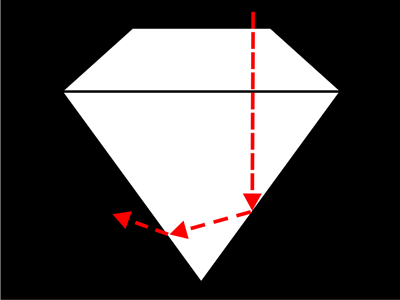
IF THE CUT IS TOO DEEP,
THE LIGHT REFLECTS AT THE OPPOSITE SIDE GOING DOWN
This is also not an ideal cut, as the light is not reflecting back into the stone, but is going out from the side. Precise positioning of each facet matters, so they all act like tiny mirrors reflecting back for maximum brightness.
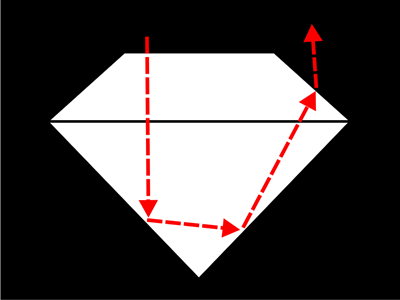
WHEN THE CUT IS PROPORTIONATELY BALANCED IN HEIGHT AND WIDTH, THE REFRACTION
OF LIGHT MEETS THE IDEAL CONDITIONS, AND LIGHT IS REFLECTED UP INTO THE STONE
This cut adds brightness and luster to the stone bringing out its intrinsic beauty to the surface. The cut of a diamond is thus seen as the most crucial aspect while selecting one.
Our Stone Shapes
Nowadays, we find diamonds and other lab made stones; in various shapes and colours. It is important to choose the right shape of stone for your jewellery, depending on its design. Here, at Carat Infini we have a number of shapes and patterns to choose from. The shape refers to the geometrical outline of the stone and not the different facets of the stone. Here below, you will find some of the more common shapes available on our website:
Round : This cut in the undisputed king of brilliants, having 57 carefully placed facets. It was developed by Marcel Tolkovshy in the early 1900's. When polished to perfection, this shape has the potential of being a jewellery masterpiece and is thus seen to be the most popular shape in most jewellery worldwide. When a round diamond is cut to perfection, it can achieve the greatest amount of light dispersion and brilliance.
Princess : This shape is the second most popular shape in cut diamonds. It was introduced in the 1960's by a man named Arpad Nagy, from London. It was specially created to reduce wastage while at the same time emulate the brilliance and fire of a well cut diamond. In a round cut world, the PRINCESS is unique. It costs the least compared to any other shape stone, per carat ; due to its better yield from a rough diamond.
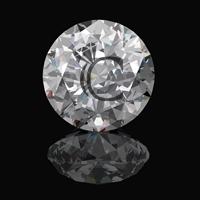
ROUND

PRINCESS
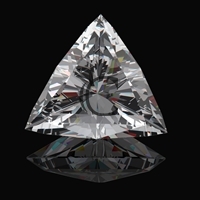
TRILLION
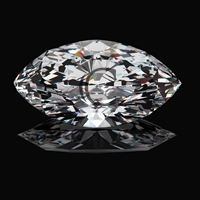
MARQUISE
Trillion - This stone shape is triangular, but it has many other variations to it. It could have curved or uncurved sides. The shape of the top surface could be different too. It was first introduced by the Asscher brothers in Amsterdam and was later trademarked by Henry Meyer Diamond Company in New York. It displays a very sharp brilliance of fire, if cut to the ideal depth. It is found to have between 31 to 50 facets, depending on its use. They are used to accent other stones, but can look very striking as solitaires too.
Marquise - The Marquise diamond also known as the navette cut, has a long and slender shape. They tend to appear bigger than their carat weight and portray an elegant appearance. This cut can usually have between 56 -60 facets depending on it pattern. Symmetry is very important in this kind of shape. A length to width ratio of 1.75 : 2.15, is considered the classic marquise cut. The colour of the diamond may also be more darker near the points of this shape. The tips of the marquise cut can be prone to damage if not well protected, in the jewellery setting.
Oval - This cut was conceived by a man named Lazare Kaplan from Russia in the 1960's. The Oval exhibits a style of elegance no other shape can exuberate. They appear larger that their actual carat weight. Their elongated shape flatters the look of short fingers, by making them appear longer and slimmer. The Oval has an ideal length to width ratio of 1.35 -1.65 (L/W) and typically consists of 56 facets. Clarity and colour are important factors in this cut, as inclusions and flaws are more easily visible.
Radiant - Radiants come in two shapes, namely; square and rectangular. It is a hybrid of the round, asscher and emerald cut. It has the fire and brilliance of the round cut, the clipped corners of the asscher and the openness of the emerald. It presents a series of concentric circles radiating from the center. This style hides flaws and colour tints , due to its brilliance and scintillating effects. The square radiant has more brilliance, while the rectangular radiant is more fiery due to more disbursement of light.
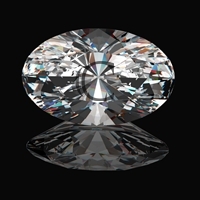
OVAL
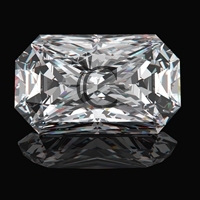
RADIANT
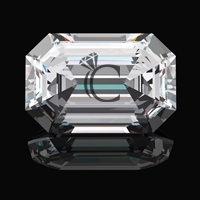
EMERALD
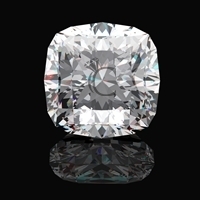
CUSHION
Emerald - This shape was initially used to cut real emeralds, and only later on due to its popularity was introduced to cut diamonds too. It usually takes on a rectangular outline and has blocked corners to give it a distinct classic appearance. With its step cut and parallel facet structure, it doesn't bend or reflect light as much. This makes it difficult to hide flaws that may be present within the stones structure. Its classic appearance and unique optical properties make it a very suitable choice in vintage designs.
Cushion - The Cushion cut has 58 facets and highly distinguishable curved corners that make it look like a pillow. Thus, it is also popularly known as the pillow cut. This cut comes in a variety of shapes, from more squarish to rectangular shapes. This shape tends to trap light, more than round diamonds, thus making them show more colour than normal round diamonds. Over the years, various cutting style have been developed, to give more variations in effect. Because of its extra facets, this cut disperses more light and can hide inclusions and flaws within it efficiently.
Baguette - A baguette cut accentuates the stones luster, whiteness and clarity, and downplays its fire. These stones are typically preferred as side or accent stones, rather than placed in the center. These stones traditionally have 14 facets, are cut in steps and have a rectangular shape. They have straight sides and four sharp corners. This cut was popular in the 1920 -1930, when geometric forms with clean straight lines were preferred. Although this cut closely resembles the emerald cut style, they are each distinct in their own way. They are mostly placed, side by side in paved and channel settings.
Heart - Heart diamonds are popular in shape because they are related to love and all things romantic. They are brilliant cuts with curved lobes that stem from a centered cleft. Heart shaped stones tend to retain body colour near the pointed tip, so colour of the stone is important. Inclusions and blemishes show up very easily on this style too. The optimal length to width ratio is 0.90 :1.10 . Its shape and symmetry are important considerations while choosing a heart shaped stone.

BAGUETTE
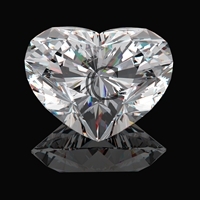
HEART
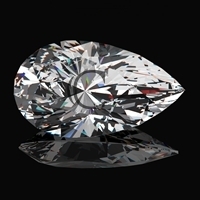
PEAR
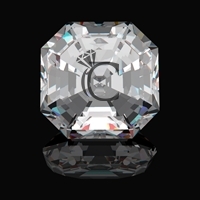
ASSCHER
Pear - This shape is mostly used in pendants and earrings. Like other fancy stones, Pears come in various shapes and sizes. The Pear is a combination of the round and the marquise cut. It resembles a teardrop and has 58 facets and an ideal length to width ratio of 1.5:1 . This shape was deign in 1458 by Lodewyk Van Berquem. A diamonds colour is more noticeable in this shape of stone, and care has to be taken to protect the tip where the colour looks more concentrated. They are known for their brilliance and timeless elegance. They make a lovely centerpiece to rings and pendants.
Asscher - This cut was developed in 1902, by Joseph Asscher. It takes on a squarish appearance and has a median step cutting style of 57 facets. Its "windmill" patterning can be seen across the center of the stone. Asschers come in a variety of facet patterning styles. This choice of facet patterning depends on the on the rough crystals and the stone cutters decision to bring out the best within it. It is imperative to realise, that since asschers have reduced brilliance and scintillating effect, any inclusions and blemishes are not easily hidden. An ideal asscher would have a with ratio of 1.00:1.05. Anything beyond that will not appear squarish and will look awkward.
Diamonds, precious stones, simulants, synthetic stones and natural stones come in varying shapes, sizes, cuts, clarity, etc. It takes a skilled hand to bring out their intrinsic beauty and make them look stunningly beautiful. In the present times, due to the scarcity and every increasing prices of natural stones, simulants and other synthetics have flooded the market. These stones, although they aren't exactly alike to what you get from the earths surface, are equally stunning to the naked eye. It could be a very difficult task to tell apart one from the other, even for an individual with a very discerning eye.
We, here at Cart Infini, wishing to give you the very best of what is available, take utmost care and diligence while choosing our stones and designs. We look to give you the maximum value for your money; and hope that under your care and love they may one day be family heirlooms to the generations to follow.






































